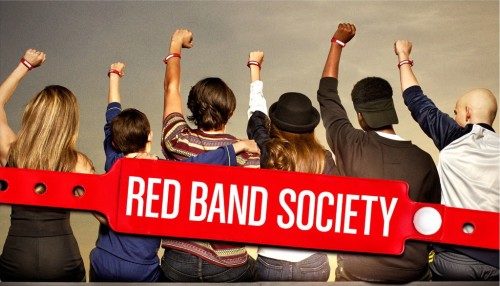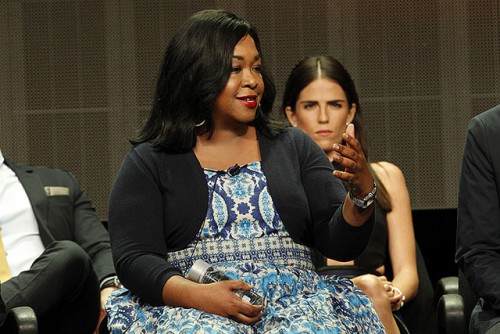Written by Max Thornton.
A TV dramedy about teens who live in a hospital is perhaps the logical next stage in a culture where The Fault In Our Stars was such a phenomenon. In fact, I would guess that someone pitched it as “Breakfast Club meets TFIOS.” Red Band Society presents the high-school dynamic explored in a sick-lit microcosm. It’s largely fluff and nonsense, but it’s quite entertaining nonsense on the whole – not least because Octavia Spencer is a treasure and is marvelous as the superheroic Nurse Jackson, while it’s an absolute joy to see My So-Called Life‘s Wilson Cruz back on TV.
Because of my interest in disability theory, I was interested to see how the high-school dynamic might play out in a hospital context, but to be honest the show isn’t doing as much with it as it could. Not least this is because of the show’s metaphysics, which it lays out there both in the premise – it’s narrated by a comatose boy who can see and hear everything that goes on around the hospital, and interact with the other patients when they are under for surgery (though not when they’re asleep, for some reason) – and in an explicit statement of mind-body dualism made by one character to another: “Your body isn’t you. Your soul is you.”
I’m so involved in body-affirming scholarship, including disability and crip theory, that it kind of shocks me when I hear such forthright statements of dualism in pop culture. Rejecting mind-body dualism wasn’t just an abstract philosophical decision for me; it dramatically changed my life. While I know (oh God, how I know) that telling yourself, “I am not my body, I am just in it” can be a life-saving consolation in times of extreme bodily distress, I don’t think it’s ultimately a tenable way to understand your existence in the world. In many ways, this is what crip theory (and its intertwined conversation partner, queer theory) is about: refusing to accept mind-body dualism and its passive reinforcement of a normative narrative about what constitutes a healthy, whole, socially acceptable body.
My point is that, despite its setting, thus far Red Band Society hasn’t shown much interest in engaging with disability tropes beyond letting its characters take time out from being ~brave and inspirational~ to be snarky, bratty, illegal-substance-pursuing teens. Which, to be fair, is a great step up from classic media portrayals of disabled people as either inhumanly angelic or miserably bitter: at least these characters are the center of their own drama, not vehicles for the edification of able-bodied people.
There are six members of the titular society:

Charlie, our comatose narrator, offers commentary primarily in the form of zingers. He has a Tragic Backstory of which every single beat has been wholly predictable, although the latest episode ended on a Charlie-related moment that was ridiculous even for this show, so who knows what’s ahead.
Leo is a recovering cancer patient whose leg had to be amputated. At least once per episode, one of the characters will remind us that pre-cancer Leo was a stereotypical jock who wouldn’t have given these people the time of day, and look how he’s grown through adversity! Soccer was Leo’s jam, and because Nurse Jackson is not bound by the laws, rules, and circumstances governing us mere mortals, she happens to know an amputee athlete who agrees to train Leo. However, Leo ultimately decides against the training, because he doesn’t want to be known as an amputee athlete. Honestly, this smacks of the writers not wanting to deal with actual amputee athletics training: wouldn’t he at least try one training session before giving up on his lifelong passion and imagined future?
Dash is Leo’s BFF. It took until the most recent episode, the fifth, before Dash finally got some characterization of his own, beyond how he relates to the other characters. Dash is also Black. JUST SAYING. When he’s not trying to seduce the young nurse, smoking weed with the ward’s resident hippiechondriac, or getting jealous over Leo (which causes all the other characters to tease him about being in love with Leo, because boys can’t have close friendships without it being gay, and everyone knows homosexuality is hilarious), Dash is a graffiti artist extraordinaire. Also his lungs don’t work right or something, but who knows, it never seems to impede his life in any way.

Emma is my favorite. She’s bookish and smart, and she tries to do what she thinks is right by people, but she has a streak of fire in her which can sometimes lead to poor decisions. She’s in hospital for anorexia, and stays in a ward with cancer patients and people needing transplants, because… reasons, I guess? Whatever its logic, this juxtaposition does make for interesting possibilities in exploring the stigmatization of mental illnesses and psychological disorders, which can occur even among communities of the sick and the disabled: Leo yells at her that she doesn’t need to be in hospital, she’s only there by her own choice.
Kara is my other favorite, the bitchy cheerleader who is completely self-aware of her role as gratuitously mean hot girl. On the whole, she revels in taking the other characters down a peg or two, though it has been hinted more than once that massive self-esteem issues underlie her unpleasantness. She has an almost symptom-free heart condition, but isn’t on the donor list because of her pill-popping. Also she has awful power lesbians for moms, because, as Charlie says in a line that is certainly a verbatim quote from the writer who suggested it, “What? Dads fall for a nanny all the time. Why not moms?”
Jordi is the new kid. (Kara is technically a new kid as well, but she can’t be the Everyman character because she’s a girl, and not just a girl but a mean girl.) He’s boring and annoying, and I feel like he and his abandonment issues walked straight off The Fosters and into this show. It’s cool that the Everyman is Latino, but I am super done talking about Jordi and his annoying hair and dumb personality.
There are some adult characters other than Octavia Spencer, too: a Dr. Sexy type who is even more annoying than Jordi (but thankfully gets less screentime); a ditzy nurse; assorted parents floating in and out – but none of them are all that interesting.
It’s not clear yet whether Red Band Society will last out the TV season. I hope it does, because, for all its faults, this show can be very charming, and I think there’s potential for something new and exciting beneath the cheese.

_____________________________________________
Max Thornton blogs at Gay Christian Geek, tumbles as trans substantial, and tweets at @RainicornMax.







